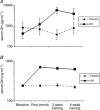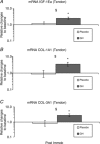Tendon and skeletal muscle matrix gene expression and functional responses to immobilisation and rehabilitation in young males: effect of growth hormone administration
- PMID: 24081158
- PMCID: PMC3872768
- DOI: 10.1113/jphysiol.2013.261263
Tendon and skeletal muscle matrix gene expression and functional responses to immobilisation and rehabilitation in young males: effect of growth hormone administration
Abstract
We examined the effect of growth hormone (GH) on connective tissue of tendon and skeletal muscle during immobilisation and re-training in humans. Young men (20-30 years; n = 20) were randomly assigned to daily recombinant human GH (rhGH) (33-50 μg kg(-1) day(-1)) or placebo (Plc), and had one leg immobilised for 2 weeks, followed by 6 weeks of strength training. The cross-sectional area (CSA), maximal muscle strength (maximal voluntary contraction, MVC) and biomechanical properties of the quadriceps muscle and patellar tendon were determined. Muscle and tendon biopsies were analysed for mRNA of collagen (COL1A1/3A1), insulin-like growth factors (IGF-1Ea/Ec), lysyl oxidase (LOX), matrix metalloproteases (MMP-2 and MMP-9), decorin and tenascin-C. Fibril morphology was analysed by transmission electron microscopy (TEM) to detect changes in the fibril diameter distribution. In muscle, CSA and MVC declined with immobilisation and recovered with rehabilitation similarly in both groups. Likewise, both groups showed increased IGF-1Ea/Ec and COL1A1/3A1 expression in muscle during re-training after immobilisation compared with baseline, and the increase was more pronounced when subjects received GH. The tendon CSA did not change during immobilisation, but increased in both groups during 6 weeks of rehabilitation (∼14%). A decline in tendon stiffness after immobilisation was observed only in the Plc group, and an increase during 6 weeks of rehabilitation was observed only in the GH group. IGF-1Ea and COL1A1/3A1 mRNA increased with immobilisation in the GH group only, and LOX mRNA was higher in the GH group than in the Plc group after immobilisation. Both groups showed an increase in MMP-2 with immobilisation, whereas no changes in MMP-9, decorin and tenascin-C were observed. The tendon fibril diameter distribution remained unchanged in both groups. In conclusion, GH stimulates collagen expression in both skeletal muscle and tendon, abolishes the normal inactivity-related decline in tendon stiffness and LOX, and results in increased tendon CSA and stiffness during rehabilitation. GH has a matrix-stabilising effect during periods of inactivity and rehabilitation in humans.
Figures







References
-
- Berg HE, Tesch PA. Changes in muscle function in response to 10 days of lower limb unloading in humans. Acta Physiol Scand. 1996;157:63–70. - PubMed
-
- Bergstrom J. Percutaneous needle biopsy of skeletal muscle in physiological and clinical research. Scand J Clin Lab Invest. 1975;35:609–616. - PubMed
-
- Claessen KM, Appelman-Dijkstra NM, Adoptie DM, Roelfsema F, Smit JW, Biermasz NR, Pereira AM. Metabolic profile in growth hormone-deficient (GHD) adults after long-term recombinant human growth hormone (rhGH) therapy. J Clin Endocrinol Metab. 2013;98:352–361. - PubMed
Publication types
MeSH terms
Substances
LinkOut - more resources
Full Text Sources
Other Literature Sources
Medical
Miscellaneous

